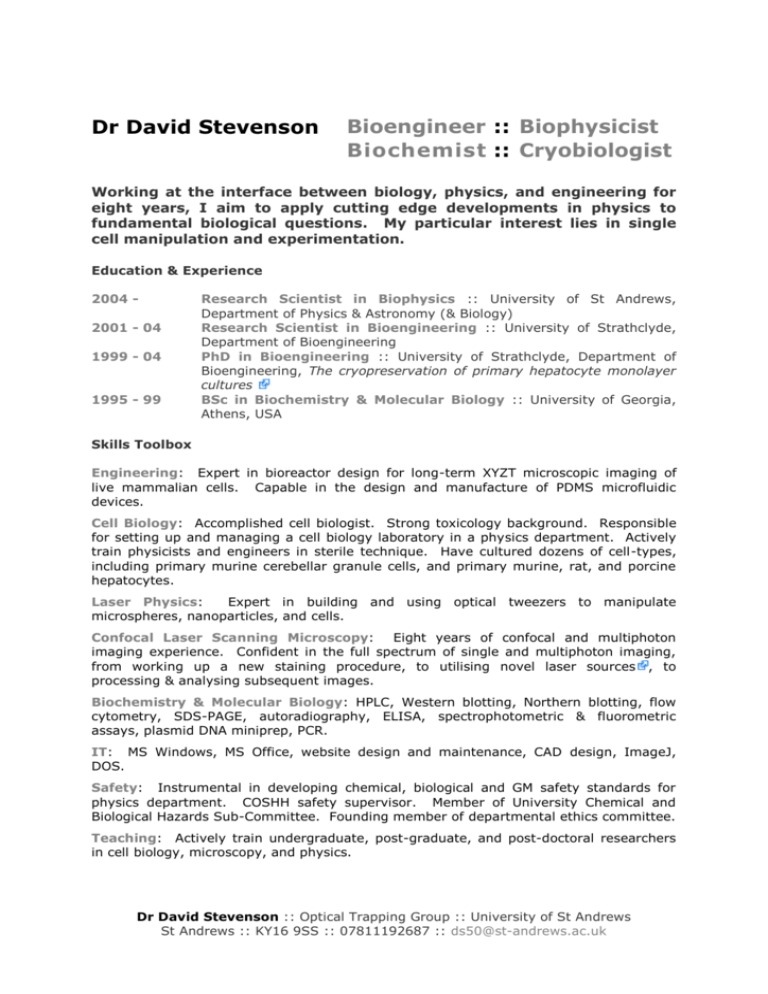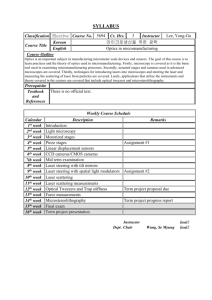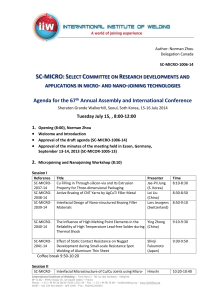Curriculum Vitae - University of St Andrews
advertisement

Dr David Stevenson Bioengineer :: Biophysicist Biochemist :: Cryobiologist Working at the interface between biology, physics, and engineering for eight years, I aim to apply cutting edge developments in physics to fundamental biological questions. My particular interest lies in single cell manipulation and experimentation. Education & Experience 2004 2001 - 04 1999 - 04 1995 - 99 Research Scientist in Biophysics :: University of St Andrews, Department of Physics & Astronomy (& Biology) Research Scientist in Bioengineering :: University of Strathclyde, Department of Bioengineering PhD in Bioengineering :: University of Strathclyde, Department of Bioengineering, The cryopreservation of primary hepatocyte monolayer cultures BSc in Biochemistry & Molecular Biology :: University of Georgia, Athens, USA Skills Toolbox Engineering: Expert in bioreactor design for long-term XYZT microscopic imaging of live mammalian cells. Capable in the design and manufacture of PDMS microfluidic devices. Cell Biology: Accomplished cell biologist. Strong toxicology background. Responsible for setting up and managing a cell biology laboratory in a physics department. Actively train physicists and engineers in sterile technique. Have cultured dozens of cell-types, including primary murine cerebellar granule cells, and primary murine, rat, and porcine hepatocytes. Laser Physics: Expert in building and using optical tweezers to manipulate microspheres, nanoparticles, and cells. Confocal Laser Scanning Microscopy: Eight years of confocal and multiphoton imaging experience. Confident in the full spectrum of single and multiphoton imaging, from working up a new staining procedure, to utilising novel laser sources , to processing & analysing subsequent images. Biochemistry & Molecular Biology: HPLC, Western blotting, Northern blotting, flow cytometry, SDS-PAGE, autoradiography, ELISA, spectrophotometric & fluorometric assays, plasmid DNA miniprep, PCR. IT: MS Windows, MS Office, website design and maintenance, CAD design, ImageJ, DOS. Safety: Instrumental in developing chemical, biological and GM safety standards for physics department. COSHH safety supervisor. Member of University Chemical and Biological Hazards Sub-Committee. Founding member of departmental ethics committee. Teaching: Actively train undergraduate, post-graduate, and post-doctoral researchers in cell biology, microscopy, and physics. Dr David Stevenson :: Optical Trapping Group :: University of St Andrews St Andrews :: KY16 9SS :: 07811192687 :: ds50@st-andrews.ac.uk Current Research Assay miniaturisation: As someone with a strong biological background working within an optical trapping group, I have been fascinated with pushing the technology to miniaturise common assays to the level of the single cell. The micromanipulation techniques I have developed also a single cell, sphere, or liposome to be dosed serially with multiple reagents without the use of fluid flow regimes. Photoporation: A common requirement for cell biologists is the ability to load membrane impermeable substances into live cells. Using a focused, femtosecond pulsed Ti:Saphire laser it is possible to bore a small transient hole into the plasma membrane of a single cell, allowing ingress of membrane impermeable substances. In 2006 I published an extensive study of this technique, which involved dosing >4000 individual cells . I was then involved in a subsequent photoporation study that employed a novel beam shape (the Bessel beam) for photoporation . We found that a Bessel beam relaxes the focusing requirement compared with a Gaussian beam profile. Significantly, this opens the possibility for the technique to be automated, making a push-button device for use in a biology laboratory a closer reality. Laser guided axon growth: When a focused near infra red laser is placed on to the leading of a growing axon, it is possible to influence both the velocity and direction of the axon. I have undertaken a detailed study of laser guided axon growth. By comparing two different wavelengths (1064 nm vs. 780 nm) of laser mediated guidance, I demonstrated that there was no significant difference between the guidance ability of a 780 nm or a 1064 nm laser . I have also shown that the effect is not temperature mediated. Neuron guidance experiments are extremely technically challenging as they require keeping cells viable on a microscopy stage for long periods of time. This led me to develop a customised long term on-stage bioreactor, based on a Carrel flask design originally invented in 1912. Since publishing a technical paper on this subject there has been great interest in this device, and a number research groups have placed orders for one. Currently, I am involved in a study to investigate the use of beamshaping techniques to alter neuronal guidance, the details of which are about to be published. Keywords of Expertise Cell culture, optical trapping, laser assisted transfection, photoporation, laser guided axon growth, quantum dots, nanosensors, long-term live cell microscopy, confocal laser scanning microscopy, phagocytosis, microfluidics, single cell analysis, fluorescent staining, cytochrome P-450, reduced glutathione, glutathione synthase, -glutamylcysteine synthetase, UDP glucuronosyl transferase. Selected Publications Carnegie DJ, Stevenson DJ, Gunn-Moore F and Dholakia K, Optically guided neuron growth using symmetric and asymmetric line traps (manuscript submitted to Optics Express) Brown CTA, Stevenson DJ, Tsampoula X, McDougall C, Sibbett W, Gunn-Moore FJ and Dholakia K, Enhanced Operation of Femtosecond Lasers for Biophotonics (invited manuscript in preparation for the Journal of Biophotonics) X Tsampoula, V Garcés-Chávez, M Comrie, Stevenson DJ, MB Agate, F Gunn-Moore, CTA Brown and K Dholakia, (2007) Femtosecond cellular transfection using a non-diffracting light beam, Appl Phys Lett 91, 053902 Stevenson DJ, Lake TK, Agate B, Gárcés-Chávez V, Dholakia K, and Gunn-Moore F (2006), Optically guided neuronal growth at near-infrared wavelengths, Optics Express 14 (21): 9786-9793 Stevenson DJ, Agate B, Tsampoula X, Fischer P, Brown CTA, Sibbett W, Riches A, Gunn-Moore F, and Dholakia K (2006), Femtosecond optical transfection of cells: viability and efficiency, Optics Express 14 (16): 71257133 Stevenson DJ, Morgan C, McLellan LI, Grant MH, Reduced glutathione levels and expression of the enzymes of glutathione synthesis in cryopreserved hepatocyte monolayer cultures, (2007) Toxicology in Vitro 21(3), 527-532 Stevenson DJ and Grant MH (2005), Cryopreservation of hepatocytes for bioartificial liver devices. in Bioreactors for tissue engineering: principles, design and operation (Eds JB Chaudhuri and M al-Rubeai) Kluwer Academic Publishers, Chapter 16 Stevenson DJ, Morgan C, Goldie E, Connel G, Grant MH (2004), Cryopreservation of viable hepatocyte monolayers in cryoprotectant media with high serum content: metabolism of testosterone and kaempherol post-cryopreservation, Cryobiology 49(2):97-113 Stevenson D, Wokosin D, Girkin J, Grant MH (2002), Measurement of the intracellular distribution of reduced glutathione in cultured rat hepatocytes using monochlorobimane and confocal laser scanning microscopy, Toxicol in Vitro 16: 609-619






